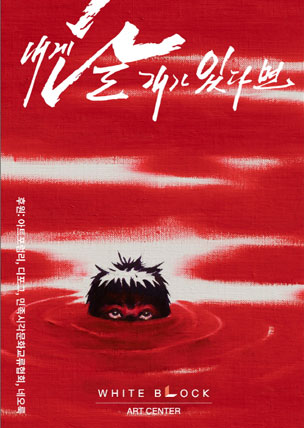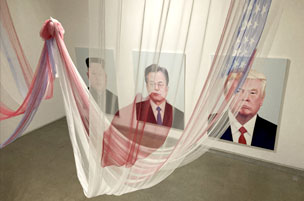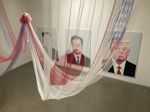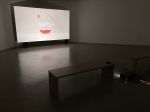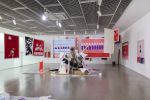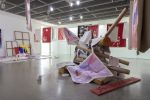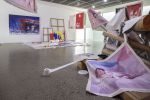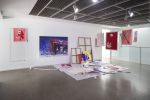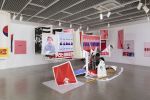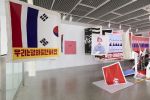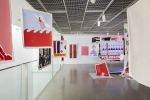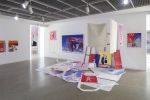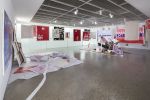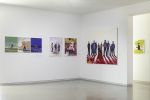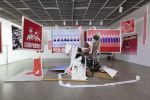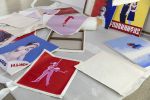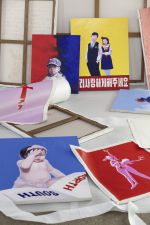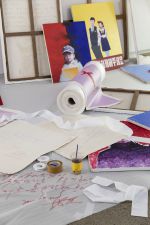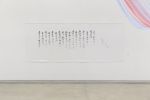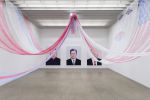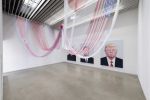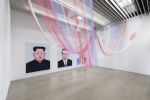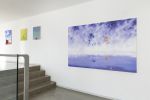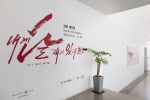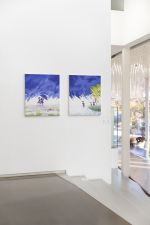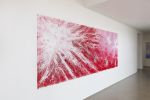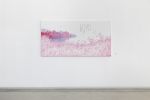D
If I Had Wings
Sun Mu
(Art Center White Block, Paju/Südkorea, 2020)If I HAD WINGS Fotogalerie
Text: Jae-Hyun Yoo
It has already been 12 years since I first met the faceless artist, Sun Mu. Perhaps because of the prejudice I had against him as he came from North Korea, a place so near and yet so far, I sensed the feeling of awkwardness in his strong expressions that are difficult to describe in words at our first encounter. His actions were frank and without reserve. They were frank but there was a certain level of anxiety that would not reveal itself. His artworks seemed to reflect both his inner and outer world with their eccentric and strong expressions and colors. There are times when we feel the smell of the terrapin and linseed oil sting our nose and make us dizzy while standing in front of an oil painting. I still have vivid memories of experiencing such dizziness as I stood in front of the multiple artworks piled up on each other during my first visit to a rooftop studio during one summer day. I remember, the symbolism portrayed by darker red painted on red and darker blue painted on blue, the visual dizziness along with the intense feelings the artworks themselves generated and the peculiar anxiety reflected in them. Back then, I imagined of an exhibition where all the artworks containing the traces of his time are gathered in a single space, and thought, if only I had the chance to make it real.
The Taken and the Remembered
I once visited the Museum of Asian Arts located in the Dahlem neighborhood, South of Berlin, when I was studying in Germany. Starting from Indian art to fine arts of Southeast Asia to modern art, a wide variety of artworks were displayed there. I was astonished to find the collection of Korean pottery and artifacts that were looted when Japan invaded Joseon, and at another exhibition hall, I was shocked at the gigantic stone cave that was taken from China. Only half of the cave was displayed, and the Director actually travelled to China to see the other half of the cave. He mentioned that he still remembers the shame and humiliation he felt back then as a citizen of a predator country.Sun Mu’s artworks convey the feeling of half-completeness. Such half-completeness serves as an additional explanation as to why the audience feel some sort of awkwardness in his artworks. The other half of, which has been looted during the colonial era, contains the history education he learnt in North Korea that I am not aware of together with vivid memories of his life in China that extends well into Korea. Yes, the North and the South are history of the pillage executed by the powerful neighbors. That is why he tries to visualize his memories as a personal memory that flows throughout history and continues to remain relevant. As such, he is predestined to continue ahead without stopping. I wonder if he remind you of a fish flopping to survive after swallowing the poison of ideology?
If I Had Wings
Would birds have borders high up in the sky?Does ideology exist in their world?
Chinese people, American people
German people, French people...
People of all nationalities meet one another with freedom abound
But not the brothers and sisters from South and North Korea
What a bewildering situation 5,000 years of history
If I had wings
I would fly over the mountains and rivers
To see the dear faces I had yearned for so long
2020.9.21 Sun Mu, from the Southern land
If he ‘had wings’, he would fly immediately, somewhere. Where would the destination be? His homeland where his parents reside, or could it be a corner in his hometown where he feels a sense of freedom while secretly puffing away? I look forward to an exhibition that fills in the memories of those years and the empty half left after what has been taken away.
Oftentimes, Sun Mu mentioned that he feels bound by invisible shackles before exhibitions. Those who are not aware of his story might wonder why because he already fled from North Korea long ago. However, this is not a matter of one side being a devil and the other an angel. The South and the North are simply halves that have been despoiled, a home he can never forsake. That is why his desire to express his honest experiences of the two halves through artworks is only natural.
With this motivation in mind, Sun Mu aspires to reflect his authentic stories of the past 18 years in Korea in the form of artworks. If the methods he adopted were inflammatory in the past such as taking the form of political posters, he mostly uses Joseon painting techniques in this exhibition. The Joseon painting techniques bring out nostalgia he doodled on ever since childhood. The Greek word “nostalgia” is a combination of “nostos”, which means return, and ”algos”, which means pain. Just as the word nostalgia itself suggests, Sun Mu continues to endure the life of suffering, unable to return to that which he longs for.
The isolation COVID19 brought with it may be attributable to the ever more profound remembrance of the memories of the past in recent days. However, the virus called coronavirus failed to stop the movement of his fingertips. It made him rather struggle and strive harder to break free from the isolation. Such fierce struggles and brush strokes for freedom are perhaps Sun Mu’s destiny.
내게 날개가 있다면
글: 유재현, 독립기획자얼굴 없는 작가 선무를 만난 지도 12년이라는 시간이 훌쩍 지나갔다. 가깝고도 먼 북한이란 곳에서 왔다는 선입견이 있어서인지 첫 만남에서 본 그의 인상과 몸짓에서 무언가 형언할 수 없는 강한 표현과 어색함이 함께 했다. 그의 행동은 격이 없고 솔직해 보였다. 그래서 숨김이 없지만 그 속에 보이지 않는 불안함이 존재했다. 그가 보여주는 작품 또한 특이하고 강한 표현과 색감으로 그의 내면과 외면세계를 반영하고 있는 듯했다. 때로 우리가 유화 앞에 서면 테라핀과 린시드 오일의 교묘한 조화가 코를 찌르고 사람을 어지럽게 만든다. 나는 이렇게 여름날 처음 접한 옥탑방 작업실에서 첩첩 쌓아 올려진 많은 작품 앞에서 바로 이러한 현기증이 일어난 기억이 생생하다. 빨간색 속에 그려진 더 짙은 빨간색, 파란색 속에 그려진 더 짙은 파란색이 보여주는 상징성은 그의 작업에 베인 강렬함과 독특한 불안함과 더불어 시각적 현기증을 만들어낸 것으로 기억된다. 당시 언젠가 기회가 된다면 그의 시간의 흔적이 나타나는 작품을 한곳에 모아 놓은 전시를 상상해 본 적이 있었다.
빼앗긴 것과 기억되는 것
내가 독일 유학 시절 베를린 남쪽 달렘에 위치한 아시아 예술 박물관을 방문한 적이 있다. 이곳에는 인도의 예술부터 동아시아의 고전미술 그리고 현대미술까지 다양하게 전시되어 있었다. 일본이 조선 침략기 때 약탈한 도자기와 소품의 존재를 보고 놀라웠고, 또 한 전시관에 놓인 중국에서 빼앗아 온 어마어마한 규모의 절반만 전시된 석조조각 동굴을 보면서 정말 충격적이지 않을 수 없었다. 이 박물관 관장은 실제로 중국을 가서 나머지 동굴의 절반을 보고 왔다고 했고, 그때 그가 가져야 했던 약탈한 국가의 국민으로서 수치심을 아직 잊을 수 없다고 했다.선무의 작품 속에는 절반의 완성이 존재한다. 이 절반의 완성이 작품의 어색함을 느낄 수 있는 그 이유의 부연설명이다. 식민지 시대의 약탈당한 절반 속에는 내가 모르는 북한에서 배운 역사교육과 그의 중국과 한국에서의 생활이 연장된 기억이 생생히 담겨 있다. 그렇다. 그가 보는 남북은 주변 강대국으로부터 약탈당한 역사이다. 그래서 그가 가진 기억을 역사 속에서 멈추지 않고 개인의 기억으로 시각화하려고 노력한다. 이렇게 멈출 수 없는 것이 그의 운명이다. 이는 이데올로기라는 독을 마시고 살아남기 위해 꿈틀거리는 물고기와 같지 않을까 상상해 보라.
내게 날개가 있다면
저 하늘의 새들도 국경이 있을까?이데올로기가 있을까?
중국사람, 미국사랑
독일사람, 프랑스 사람...
지구에 사는 사람들 다 만날 수 있는데
오직 남북의 형제들만 만날 수가 없구나
오천년 력사에 이게 원말이더냐
내게 날개가 있다면
저 산과 강을 넘어
그리운 얼굴들을 만나리라
2020.9.21 남녁땅에서 선무
‘내게 날개가 있다면’ 그는 당장 어딘가로 날라 갈 것이다. 어디일까? 부모가 있는 고향일까, 몰래 파는 담배를 피우면서, 그곳의 자유로움을 느끼는 북쪽 고향 주변 어느 한 곳일까? 이번 전시는 그간의 기억과 빼앗긴 절반을 채워내는 기회가 되지 않을까 기대한다.
선무는 전시 기회가 주어질 때마다 무언가 모를 보이지 않은 족쇄 같은 것이 느껴진다고 말한다. 사연을 모르는 누구는 북한을 떠났는데 어떻게 그런 생각이 들까라고 의구심이 들지도 모른다. 그에게는 어느 쪽이 악마이고 어느 쪽이 천사 같은 존재가 아니다. 남북은 그저 그에게 빼앗긴 반과 반일뿐이다. 그리고 그가 버릴 수 없는 고향이다. 그래서 경험한 이 반과 반을 더욱 솔직히 작품으로 이야기하고 싶어 하는 욕망이 그에게 본연적으로 존재한다.
선무는 이러한 동기를 가지고 한국에 와서 생활한 18년 동안 못다한 진솔한 이야기를 작품으로 담아내고자 한다. 그동안 정치 포스터와 같은 선동적인 방식으로 표현했다면 이번 전시에는 조선화 기법을 많이 사용한다. 조선화 기법은 선무가 어린 시절부터 끄적이며 그려왔던 노스텔지어를 되살리는 기법이다. 그리스어 노스텔지어는 귀환의 의미를 담는 노스토스(nostos)와 괴로움의 뜻을 담는 알고스(algos)가 합쳐져 만들어진 단어이다. 향수가 가진 의미처럼 선무는 그리움으로 돌아가고 싶지만 돌아갈 수 없는 번뇌의 삶이 연속된다.
최근 더욱 과거 생각을 하게 된 것은 아마도 COVID-19가 가져다준 고립 속에서 기억의 되새김이 그 원인지지 않을까 한다. 그렇지만 코로나라는 바이러스가 그의 손끝의 움직임을 멈추지 못했다. 오히려 더욱 이 고립 속에서 뛰쳐나가려고 애쓰며 발버둥 친다. 이러한 자유를 향한 치열한 몸부림과 붓질은 어쩌면 선무가 가진 숙명인지 모른다.
U
